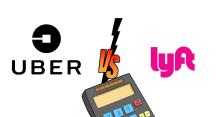- Log in to post comments

Ride-sharing platforms have become an integral part of the modern transportation landscape, offering flexible income opportunities for drivers. Two major players in this industry, Uber and Lyft, dominate the market. In this article, we will delve into a detailed comparison of earnings between Uber and Lyft in New Jersey state utilizing accurate income calculations based on the earnings data from the state of New Jersey. It is crucial to note that the earnings discussed here are exclusive of tips, bonuses, or any other additional earnings beyond the base fare, pay per mile, and pay per minute.
Uber Earnings Accuracy:
The earnings calculation for Uber is highly accurate, reflecting the earnings structure in the state of New Jersey. Uber's formula includes a base fare, time rate, and distance rate. It's important to note that Uber has a transparent and straightforward earnings model, making it easier for drivers to understand how their earnings are calculated. The accuracy of earnings plays a crucial role in the driver's satisfaction and financial planning.
Lyft Earnings and the Upfront System:
"Lyft, on the other hand, implemented the Upfront system in 2022, revolutionizing how drivers perceive and calculate their earnings. This system allows drivers to view all relevant passenger information, including trip costs, before accepting a ride. While the earnings from Lyft may not be as precisely calculable as Uber's, they are close to reality due to the transparency provided by the Upfront system, which is calculated using various factors, as Lyft has stated.
Advantages of Lyft in Short Distances:
Lyft stands out for its exceptional performance in short-distance rides. The platform tends to offer higher earnings for drivers on shorter trips, making it an attractive option for drivers operating in areas with frequent short rides. This feature can be advantageous for drivers who prefer or operate in densely populated urban environments.
Upfront Information for Better Decision-Making:
The Upfront system from Lyft gives drivers access to crucial trip details, such as the estimated fare and route, even before the trip begins. This information empowers drivers to make informed decisions and accept rides that align with their preferences and financial goals. Unlike traditional ride-sharing models, Lyft's Upfront system ensures that drivers are not left in the dark about trip details.
Trip Details
One notable drawback of Uber is that drivers operate in relative darkness before the ride begins, unaware of any details about the passenger. In contrast, Lyft allows drivers to access information like fare, addresses, and estimated duration and distance before and after the trip starts.
Conclusion:
It's important to emphasize that the earnings discussed in this comparison are exclusive of tips, bonuses, or any other additional earnings beyond the base fare, pay per mile, and pay per minute. While Uber provides precise earnings calculations based on a clear and established formula, Lyft's introduction of the Upfront system adds a new dimension to driver transparency and decision-making. Lyft's earnings, though not as easily calculable, are close to reality due to the visibility provided by the Upfront system. The choice between Uber and Lyft may depend on various factors, including the driver's preference for transparency, the type of rides they prefer, and the importance of accurate earnings calculations. In the evolving landscape of ride-sharing, both platforms continue to compete for driver satisfaction and market dominance.
Lyft and UberX Earnings Calculator and Comparison
Results
Lyft Earnings: $0
UberX Earnings: $0